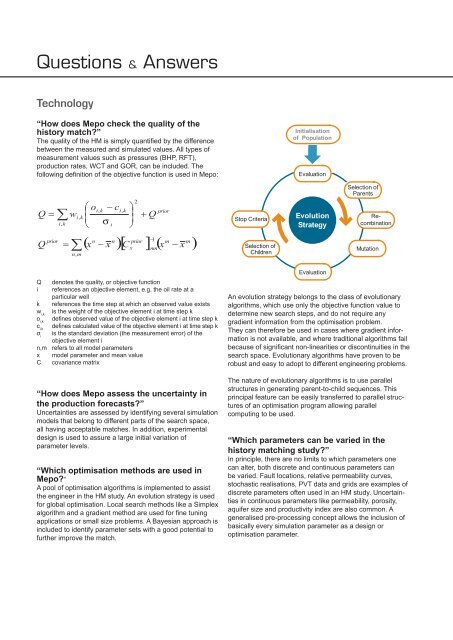A framework for history matching - StreamSim Technologies, Inc.
A framework for history matching - StreamSim Technologies, Inc.
A framework for history matching - StreamSim Technologies, Inc.
Create successful ePaper yourself
Turn your PDF publications into a flip-book with our unique Google optimized e-Paper software.
Questions & Answers<br />
Technology<br />
“How does Mepo check the quality of the<br />
<strong>history</strong> match?”<br />
The quality of the HM is simply quantified by the difference<br />
between the measured and simulated values. All types of<br />
measurement values such as pressures (BHP, RFT),<br />
production rates, WCT and GOR, can be included. The<br />
following definition of the objective function is used in Mepo:<br />
Q denotes the quality, or objective function<br />
i references an objective element, e.g. the oil rate at a<br />
particular well<br />
k references the time step at which an observed value exists<br />
w is the weight of the objective element i at time step k<br />
i,k<br />
defines observed value of the objective element i at time step k<br />
oi,k ci,k σi defines calculated value of the objective element i at time step k<br />
is the standard deviation (the measurement error) of the<br />
objective element i<br />
n,m refers to all model parameters<br />
x model parameter and mean value<br />
C covariance matrix<br />
“How does Mepo assess the uncertainty in<br />
the production <strong>for</strong>ecasts?”<br />
Uncertainties are assessed by identifying several simulation<br />
models that belong to different parts of the search space,<br />
all having acceptable matches. In addition, experimental<br />
design is used to assure a large initial variation of<br />
parameter levels.<br />
“Which optimisation methods are used in<br />
Mepo?“<br />
A pool of optimisation algorithms is implemented to assist<br />
the engineer in the HM study. An evolution strategy is used<br />
<strong>for</strong> global optimisation. Local search methods like a Simplex<br />
algorithm and a gradient method are used <strong>for</strong> fine tuning<br />
applications or small size problems. A Bayesian approach is<br />
included to identify parameter sets with a good potential to<br />
further improve the match.<br />
An evolution strategy belongs to the class of evolutionary<br />
algorithms, which use only the objective function value to<br />
determine new search steps, and do not require any<br />
gradient in<strong>for</strong>mation from the optimisation problem.<br />
They can there<strong>for</strong>e be used in cases where gradient in<strong>for</strong>mation<br />
is not available, and where traditional algorithms fail<br />
because of significant non-linearities or discontinuities in the<br />
search space. Evolutionary algorithms have proven to be<br />
robust and easy to adopt to different engineering problems.<br />
The nature of evolutionary algorithms is to use parallel<br />
structures in generating parent-to-child sequences. This<br />
principal feature can be easily transferred to parallel structures<br />
of an optimisation program allowing parallel<br />
computing to be used.<br />
“Which parameters can be varied in the<br />
<strong>history</strong> <strong>matching</strong> study?”<br />
In principle, there are no limits to which parameters one<br />
can alter, both discrete and continuous parameters can<br />
be varied. Fault locations, relative permeability curves,<br />
stochastic realisations, PVT data and grids are examples of<br />
discrete parameters often used in an HM study. Uncertainties<br />
in continuous parameters like permeability, porosity,<br />
aquifer size and productivity index are also common. A<br />
generalised pre-processing concept allows the inclusion of<br />
basically every simulation parameter as a design or<br />
optimisation parameter.


